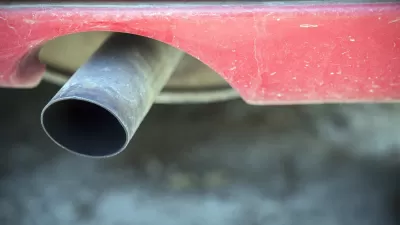Thanks to the 2010 federal requirement of ultra-low sulfur diesel fuel and new Tier 4 emissions standards by the EPA, particulate emissions from non-road diesel engines, including agricultural and construction equipment, have been reduced by 99%.
The Tier 4 emission standards [PDF] also target smog-producing nitrogen oxide, with new engines producing 99% less emissions than1996 engines. With new EPA standards already in place for trucks and buses, non-road diesel engines at "farms, construction sites and utilities" were the next target, writes Brian Bienkowski of Environmental Health News.
“It’s been a real challenge getting to this point,” said Allen Schaeffer, executive director of the Diesel Technology Forum, which represents engine manufacturers. “But all of this work has virtually eliminated nitrogen oxide and particulate matter from diesel engines.”
The rule called for a reduction of 90% over the 1996 models, but Schaeffer indicated that engine manufacturers met the higher target. However, non-road diesel engines still emit more than new buses and trucks due to the complexity of the various equipment types. "They are allowed to emit about 50 percent more grams of particles and nitrogen oxides per kilowatt-hour."
A variety of new technologies are producing cleaner farm and construction machines. Included are lower-sulfur diesel fuel, particle-trapping filters and more efficient engines with fuel-injection software, recirculated exhaust systems or catalysts that prevent pollutants from forming.
The public is the big winner with the new engine and fuel standards, as particle pollution is inked to heart attacks and respiratory disease.
"The foundation for lower emissions is ultra-low sulfur diesel fuel. In 2010 the allowable level of sulfur in diesel fuel dropped to 15 parts per million from 2007’s 500 parts per million," writes Bienkowski. Ahead of the game, as usual (due to having the nation's worst air quality though), was California, introducing the cleaner fuel as early as 2006 as we noted then.
FULL STORY: Dirty for decades, diesel tractors, bulldozers get cleaned up

Planetizen Federal Action Tracker
A weekly monitor of how Trump’s orders and actions are impacting planners and planning in America.

Maui's Vacation Rental Debate Turns Ugly
Verbal attacks, misinformation campaigns and fistfights plague a high-stakes debate to convert thousands of vacation rentals into long-term housing.

Restaurant Patios Were a Pandemic Win — Why Were They so Hard to Keep?
Social distancing requirements and changes in travel patterns prompted cities to pilot new uses for street and sidewalk space. Then it got complicated.

In California Battle of Housing vs. Environment, Housing Just Won
A new state law significantly limits the power of CEQA, an environmental review law that served as a powerful tool for blocking new development.

Boulder Eliminates Parking Minimums Citywide
Officials estimate the cost of building a single underground parking space at up to $100,000.

Orange County, Florida Adopts Largest US “Sprawl Repair” Code
The ‘Orange Code’ seeks to rectify decades of sprawl-inducing, car-oriented development.
Urban Design for Planners 1: Software Tools
This six-course series explores essential urban design concepts using open source software and equips planners with the tools they need to participate fully in the urban design process.
Planning for Universal Design
Learn the tools for implementing Universal Design in planning regulations.
Heyer Gruel & Associates PA
JM Goldson LLC
Custer County Colorado
City of Camden Redevelopment Agency
City of Astoria
Transportation Research & Education Center (TREC) at Portland State University
Jefferson Parish Government
Camden Redevelopment Agency
City of Claremont





























